ONSHORE SPEED
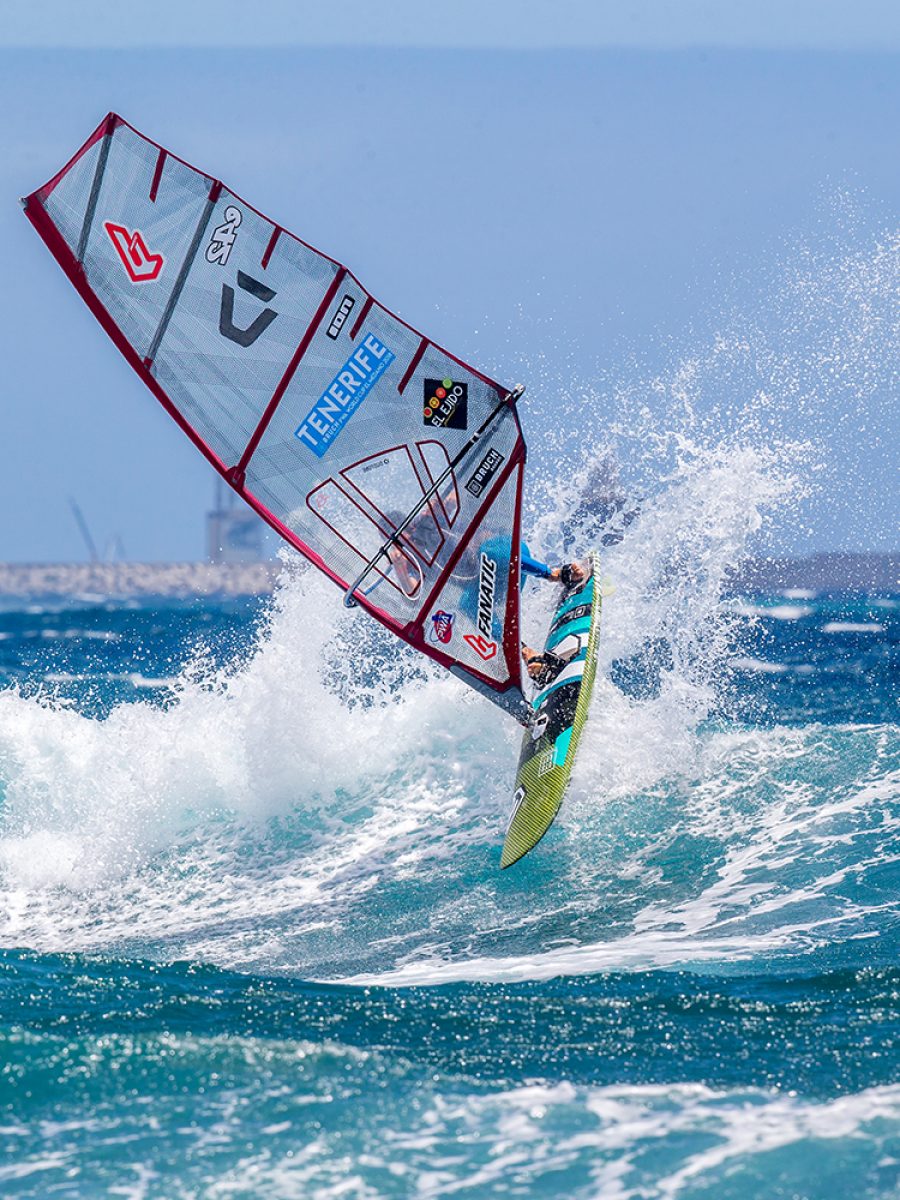
WAVE SKILLS
Words John Carter, Finn Mullen, Ben Proffitt, Dany Bruch, Adam Lewis, Robby Swift, Ricardo Campello, Jaeger Stone, Victor Fernandez, Sarah-Quita Offringa, Philip Koester, Iballa Moreno, Marcilio Browne, Werner Gnigler, Jason Diffin. // Photos John Carter, Thorsten Indra
Unless you’re blessed with consistent down the line conditions, for most of us wave sailing is about generating speed in less than ideal wind and surf. For the men and women of the PWA it’s no different when they have to compete in light and onshore conditions and this year’s PWA Wave World Cup event in El Medano, Tenerife was a prime example. John Carter went beachside in El Medano to ask the pros their tips for generating speed in typical ‘real world’ conditions, while Finn Mullen speaks to the designers of JP boards and Goya sails for their insight into the design parameters for speed generation.
VICTOR FERNANDEZ
I have a big Stubby for the lightest conditions which is my favourite. Here you need speed because the wave has no power. My Stubby is a custom 94 litre which is the same as the 99 litre production board, just scaled down. It is the perfect size for my weight. I was also using a new prototype from Duotone which is much lighter. We might release it next year. I had a 4.5m and 5.0m prototype for this competition. I talked to Raoul, to ask if I could use it in the contest and he told me yes of course. It is lighter and generates a lot of power and I can get more lift on my jumps. I can use almost one size smaller than normal.
In Tenerife you need to be in the most powerful part of the wave especially at high tide when it is a bit mushier. If you are too deep you will only get one hit when the wave closes out and that is it. Then you are stuck. It is still fun, but just trickier in onshore conditions. Tenerife can be windy also but the tactics are still similar.
“ You need to be in the most powerful part of the wave.”

ROBBY SWIFT
I think you have to use the wave more than using the sail. It is not just the lightness of the wind, I think when the wind is quite onshore, that you really have to wait at the top of the wave and drop in using the speed from that, like dropping in on a surfboard. You don’t really have any power in the sail anyway. If you try and go down the line you lose even more speed because the sail is like a handbrake. So you have to wait, drop in, stay upwind so you have apparent wind in the sail and then have the right timing. That is why when you get the timing wrong you have lost it. You might as well gybe out of the wave because normally you can fix the situation with the wind but if you time it wrong like that you are completely screwed. That is why you see riders either doing something sick or just doing nothing in similar situations. If you mess it up from the bottom turn then you can’t fix it.
I was riding 5.0m and my 88 litre board most of my heats. That 88 litre board is the board I use most of the time I sail and is the board I am most comfortable on, I use it everywhere. That exact board I have had since March and also the prototype of the production board since this time last year. It is the ‘Ultimate Wave’ quad from JP, the 2019 production board. I have used that at Ho’okipa, for all my training in Maui and all my training and competition sailing in Tenerife. I feel really comfortable on it. Our boards are designed around me wanting to compete in these conditions and to be a great board everywhere. I have been involved in the development and it has been designed to work in most conditions. It is an all-rounder. I have one Ho’okipa board which is exactly the same with a little more tail kick. That one board I just sail at Ho’okipa, other than that the Ultimate Wave is my favourite board. I have an 88 litre and an 83 litre and I pretty much only use them except in Gran Canaria where I used the 75 litre. If it was any lighter here then I would ride the 94 litre, but for 5.0m the 88 litre is fine.
Onshore wave riding is different. You have to wait for the wave to be really steep before you go. It is not tricky if you live in Tenerife, you can see the timing of the guys that live here. With practice it is all normal sailing. I like to be as light as possible for wave sailing. I used to be heavy when I was competing in slalom, I found that hindered me most in places like Tenerife when I had to go on my 94 litre and a 5.3m sail. So now I try and be as light and flexible as possible. That was diet, running, cycling, swimming, surfing and in the gym I don’t do any weights, just cardio and functional. Now I try and be skinny and flexible, I do yoga and I feel better in myself sailing in all the conditions. I don’t think it helps to be heavier than what your body is capable of.
“ Stay upwind so you have apparent wind in the sail.”
WERNER GNIGLER – JP SHAPER
Not only the young generation of riders like power on the waves, since the beginning of his career Jason Polakow is known for his high speed bottom turns and he loves fast boards –no matter if small or big waves. In wave sailing speed is your friend! Passing whitewater gets easier the quicker you are and jumps will be higher. On the wave, speed helps to position you on the desired part of the wave and to hit or avoid the steep, breaking sections.
The ‘Wave Slate’ is JP’s toy for typical European conditions – here the 3 key shape features making this board fast are:
1 – The parallel outline reduces drag and increases lift, resulting in more speed and early planing.
2 – The bottom shape combines two totally different rocker lines. On the one hand the quite flat rocker along the centreline supports early planing and overall performance partnered with a great deal of control. On the other hand, the strong V and narrow outline create more curve at the rail which takes over once ‘railed’ up.
3 – Under the footstraps, the deep single concave channels and accelerates the water to provide additional lift for early planing and speed.
The board is fast, early to plane and super efficient in generating and maintaining speed, making sessions in mediocre wave conditions very exciting. Shorter than previous concepts, these boards fit better into steep sections or smaller waves without getting stuck.The new ‘Ultimate Wave’ is the latest addition to the range merging the virtues of its predecessors. A manoeuvrable and fast board for bigger waves, the completely new bottom concept brought the crucial breakthrough in the development. The flat V in the front transforms into a double concave in the middle, then into a deep single concave under the footstraps (which create lift for early planing and channel the water for speed), and tapers off with a gentle V right at the tail. This creates a flatter scoop rocker line in the middle but keeps the curvy one on the rail. The flat centre line delivers the speed and planing power that matches the former ‘Thruster Quad’. The winger outline keeps the planing section rather wide for more lift and planing power. Overall, the ‘Ultimate Wave’ carves fast, turns smoothly and maintains speed no matter if on a huge down the line wave or a gutless onshore roller. The ‘Wave Slate’ will provide more power and fun when conditions are mediocre. As soon as the waves get bigger and the wind steady, the ‘Ultimate Wave’ is the favourite, not only for the pros!
“ Speed is your friend!”
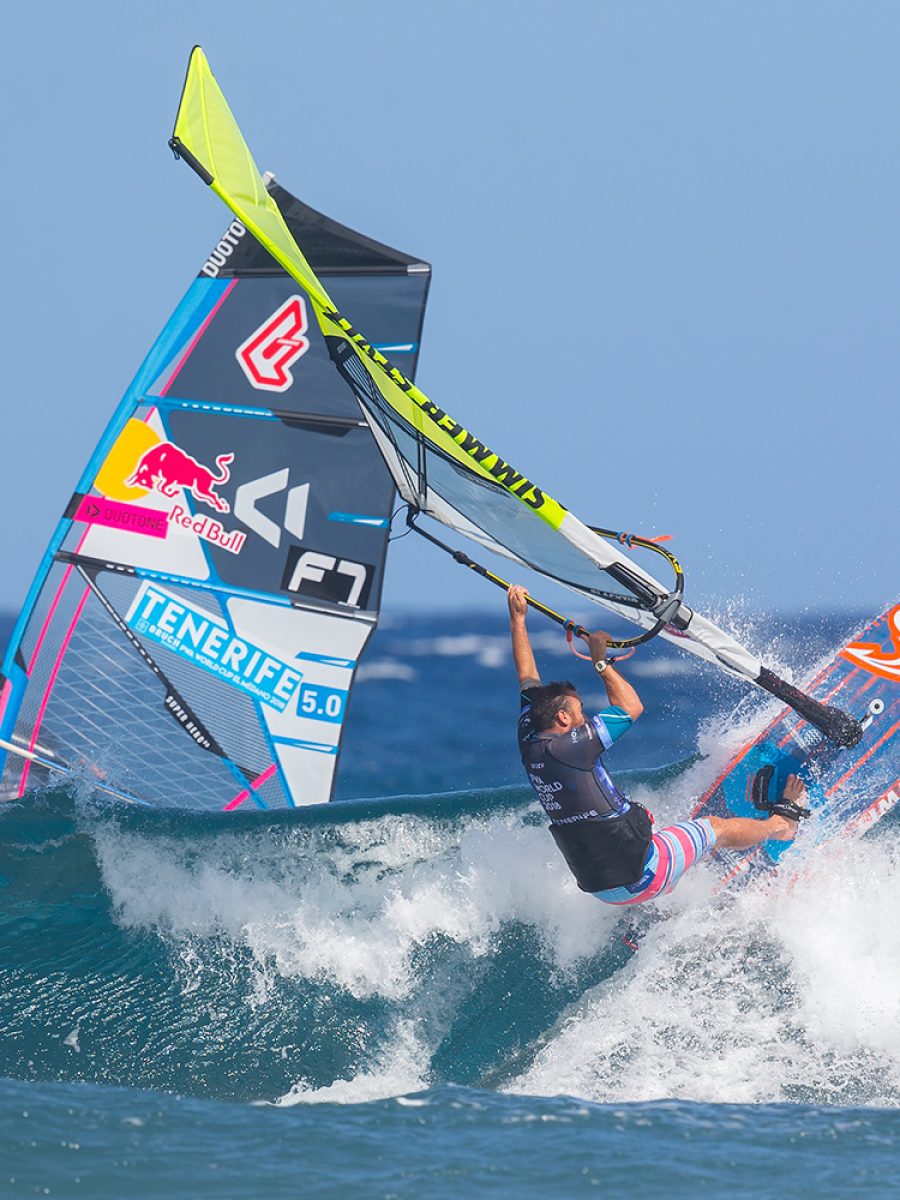
BEN PROFFITT
Everyone has different techniques, but you need a bit of width in your board. It is the same as in surfing. The width in the board keeps you moving on the wave. In Tenerife we had two types of conditions. When the waves were softer at high tide you really needed a big board with plenty of width to keep the speed. The first turn is crucial. You can’t just hack the first turn because you will most likely lose all your speed. Then you will not be able to make it down the line. When it is onshore like in Tenerife you need a big sail as well as the wide board. Your first turn should almost be the setup for the second turn. You almost use the wave like a hill. Go up the hill, come back down the hill and use that momentum to crank into that second turn.
I use a lot of quads, but I think in onshore the tri fins are probably king. They feel a bit faster and I think they give you a bit more drive with a good centre fin. I don’t rig my sails any different. If I have a big sail like a 5.3m or 5.6m I will rig it a certain way anyway. I don’t have a lot of outhaul on my sails. Our Simmer sails have quite a lot of pull from the front. I kind of use that power from the front of the sail in my technique to help me get my weight forward and over the board. In onshore don’t just sit back, especially off the top. Don’t just hack a turn and lean back, you have to bring your weight on top of the board like a surfer and assert the pressure towards the front of the board because that is what accelerates down the wave. If you paddle into a wave on a surfboard and you lean back you won’t catch the wave, so when you come off the top it is really key to get your weight right over the centre line. Also the movement of the rig is really key. Your hand goes right down the boom and as you come up you throw yourself forward and move your hand and weight forward. Hopefully as you come off the top all your weight forward will generate speed to take you into the next turn. Onshore riding is all about linking turns, you try and generate your own power and speed to continue down the line.
“ Bring your weight on top of the board like a surfer.”
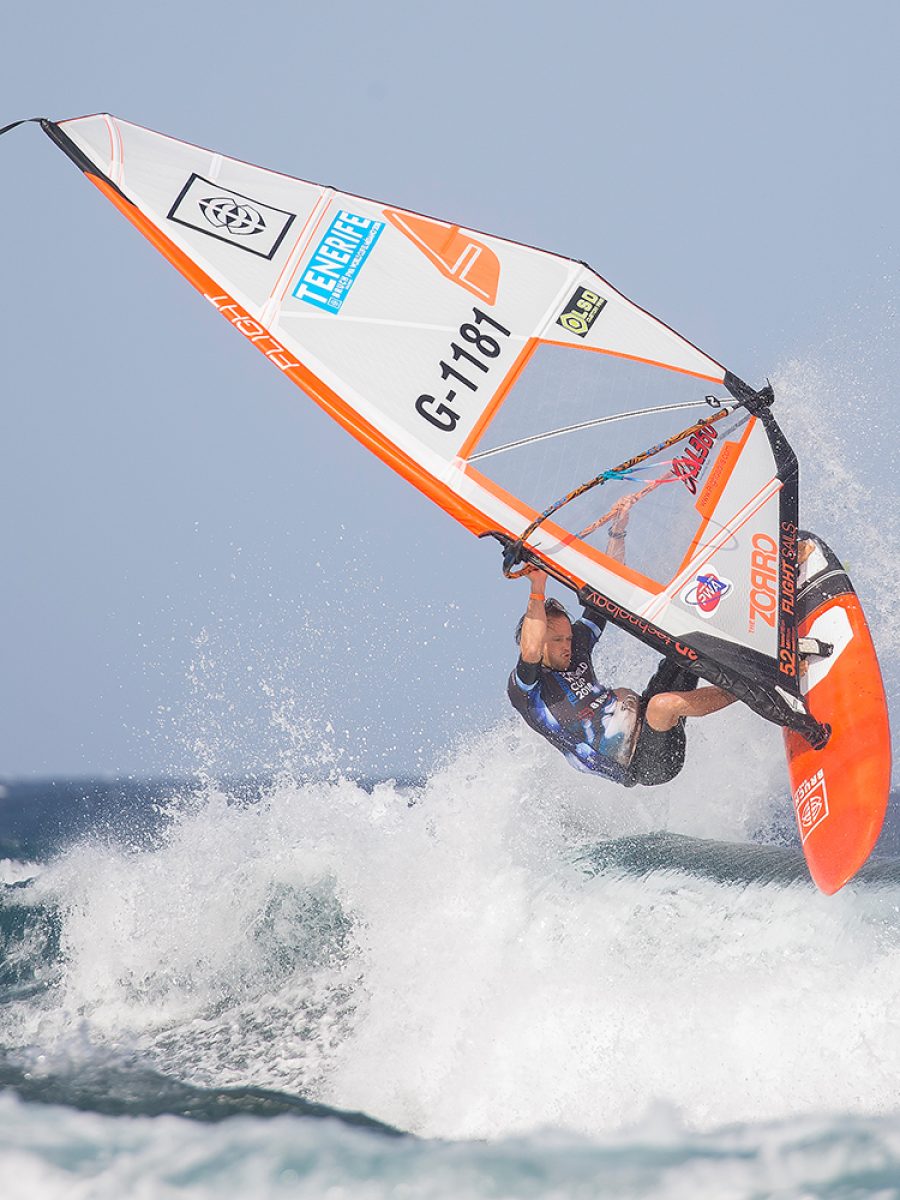
DANY BRUCH
A wider board helps generate speed when conditions are marginal. Most wave sailing is a compromise in many waves. For jumps I have a board which is a bit longer and maintains speed a bit better, but after that I prefer my wider board in the surf. During competition it is a matter of finding the best of both worlds. I am designing a new ‘black box’ type board, which is more compact and shorter with a wider tail, a bit like the style of the Stubby from Fanatic. This shape board generates similar speed to a fish board in surfing. The wider tail and wide point help keep your speed so you can engage rail to rail turns. When it is windy and hollow waves in Tenerife it is a different story, then I can use my pintail which is an amazing board. At high tide the waves can go quite flat and there you need a board that makes you go up to the lip.
“ A wider board helps generate speed when conditions are marginal.”
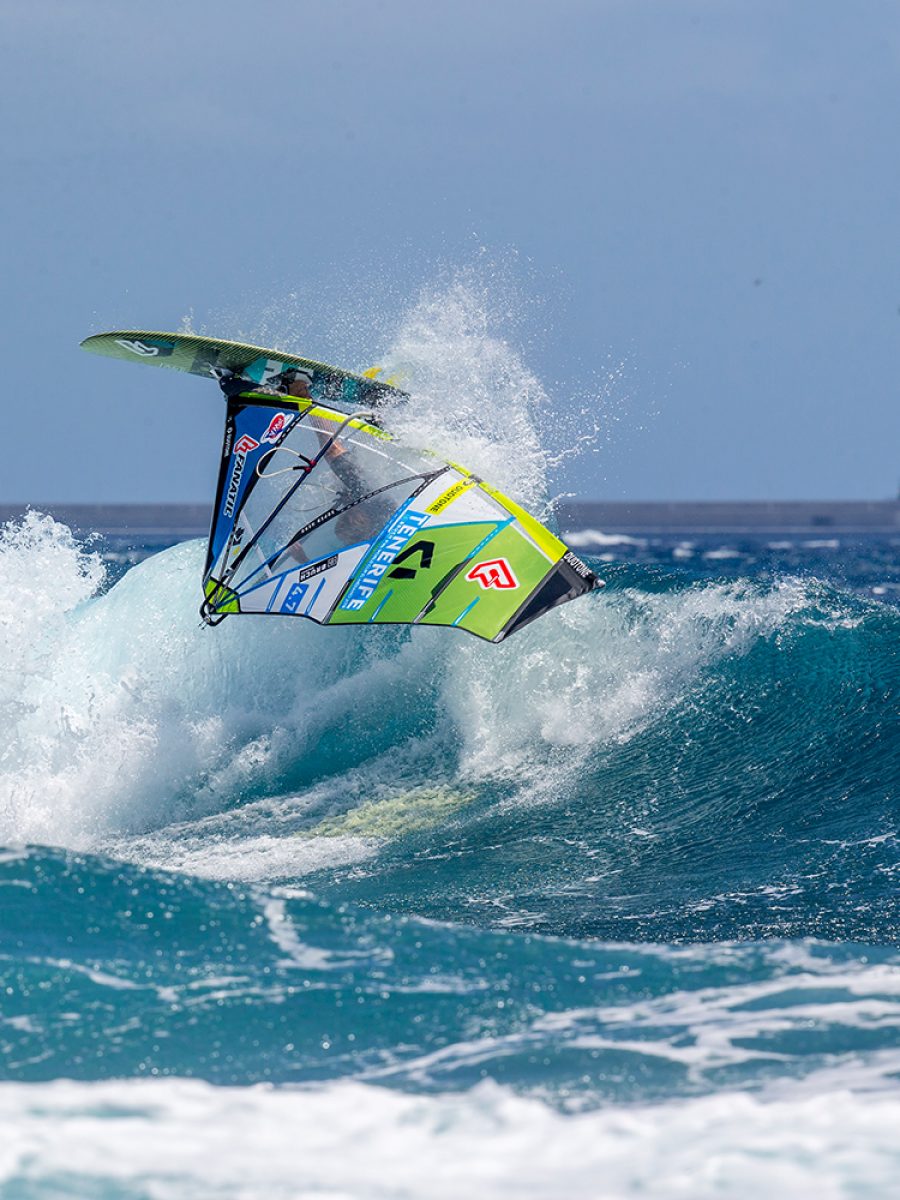
ADAM LEWIS
A big part of speed generation is equipment selection. I always choose the Stubby for example, which has a really parallel outline so the board itself creates a lot of drive. I think you have to look also at what is relevant in surfing technique. I surf a lot at home and knowing what to spot on a lacklustre wave helps loads. I know the areas of the wave that are going to generate speed. I always try and hang right at the top of the wave, right to the very last minute. In Tenerife I really try and turn just in that bottom part of the wave that is going to give me the speed and drive to come back up. So equipment that generates drive, and looking on the area of the wave that will give you speed are two good points.
The Stubby has a special parallel outline, which gives you a really long rail length; for such a short board it has a very long rail. You use this rail to drive off, which creates lift. Using that in conjunction with the wave gives you speed. If you look at Jaeger’s boards for example, they also have a long parallel section too. He is another guy that generates a lot of speed in smaller, slower waves.
I did a lot of gym training this year. It is a double whammy in the way it helps. Obviously physically it helps your strength and mobility which gives you power through a range of movement, which is really important. Secondly the training gives you confidence. That confidence in competing really helped me in particular. The majority of the exercises are kind of simple strength and condition based. Lots of squats, deadlifts, pull ups, hip thrusts and general weights, with slightly more complex movement patterns to help create the mobility. One work out a week is an explosive one which only concentrates on moving a slightly lower weight but moving it as fast as possible. After that I was having to go straight to sleep because I was destroyed. An hour of that mentally fried me. If you don’t put in one hundred per cent you are almost wasting your time so I give it everything.
On the way out through the waves I look at the situation in front of me. Most of the best guys will hang around on the inside waiting to see a patch of dark water, a gust where they can weave through the whitewater and head to the ramps. It is just a little bit of planning your route. It is easy to get sucked into blasting straight out when you are competing because you are a little bit stressed out about time. You end up wasting a lot of time. Picking your route is really important.
Long lines help you present a lot of sail to the wind rather than short lines which bring the sail close to you as you lean out! In the lighter winds I was on a 94 litre board and I am 85 kilos, so ten kilos more than my bodyweight.
“ A big part of speed generation is equipment selection.”
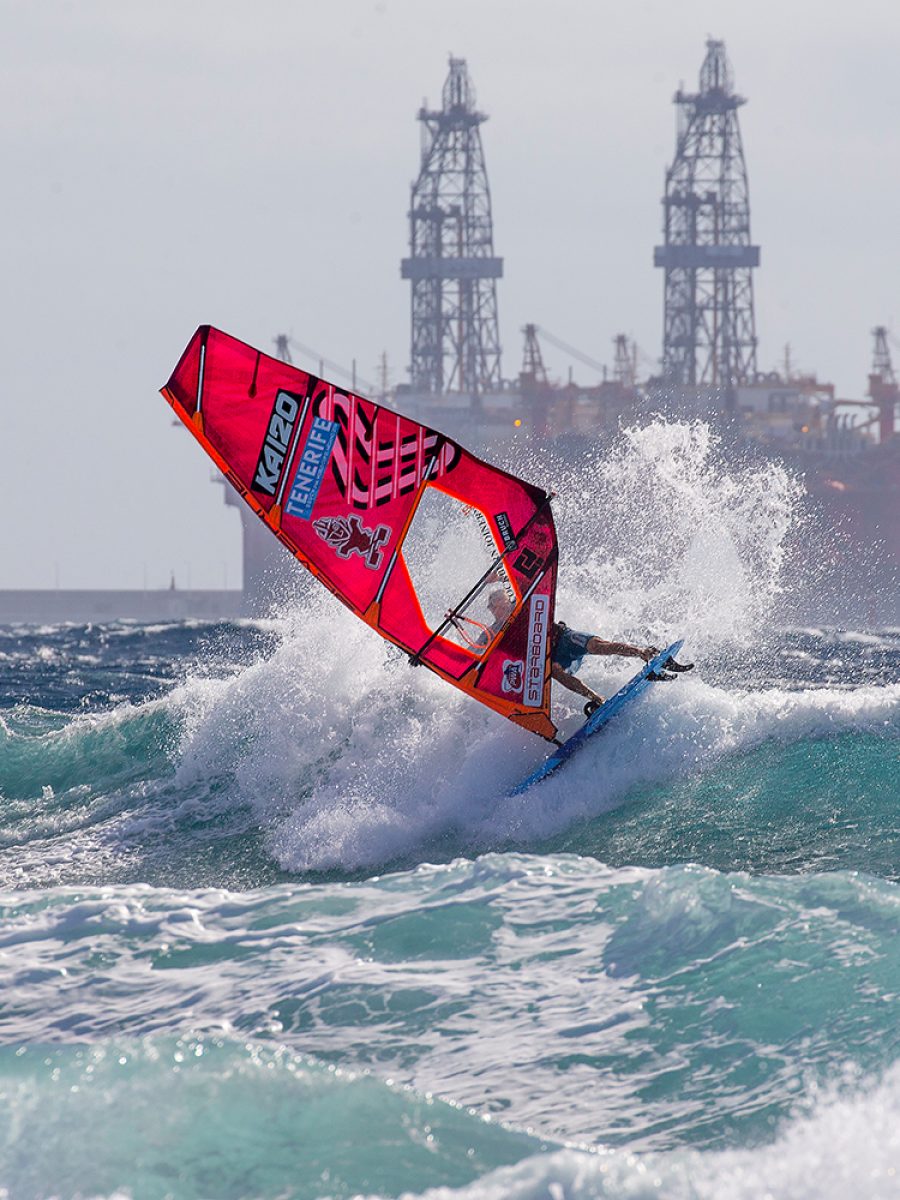
JAEGER STONE
Speed comes down to your equipment and your technique. Bending your knees helps generate a lot of speed and pushing as hard as you can. A lot of it is also the approach to riding the wave and when you decide to take the drop. It’s best to hold on to that last moment until the wave is steepest as well. I try and make the most out of all the wind in my sail. Because it is a little bit more cross onshore in Tenerife, and lighter in the surf zone, I generally take a little bit bigger sail and a bigger volume board. I use my thruster when it is windier and when it is really light I use the Starboard Air. It has a bit more width and volume and is set up as a quad because I find it is a bit more zippy and exciting to ride. Off the water I just try and stay strong. If you are strong and training in the gym then you reduce your chance of injury. That is the main thing.
“ Bending your knees helps generate a lot of speed.”
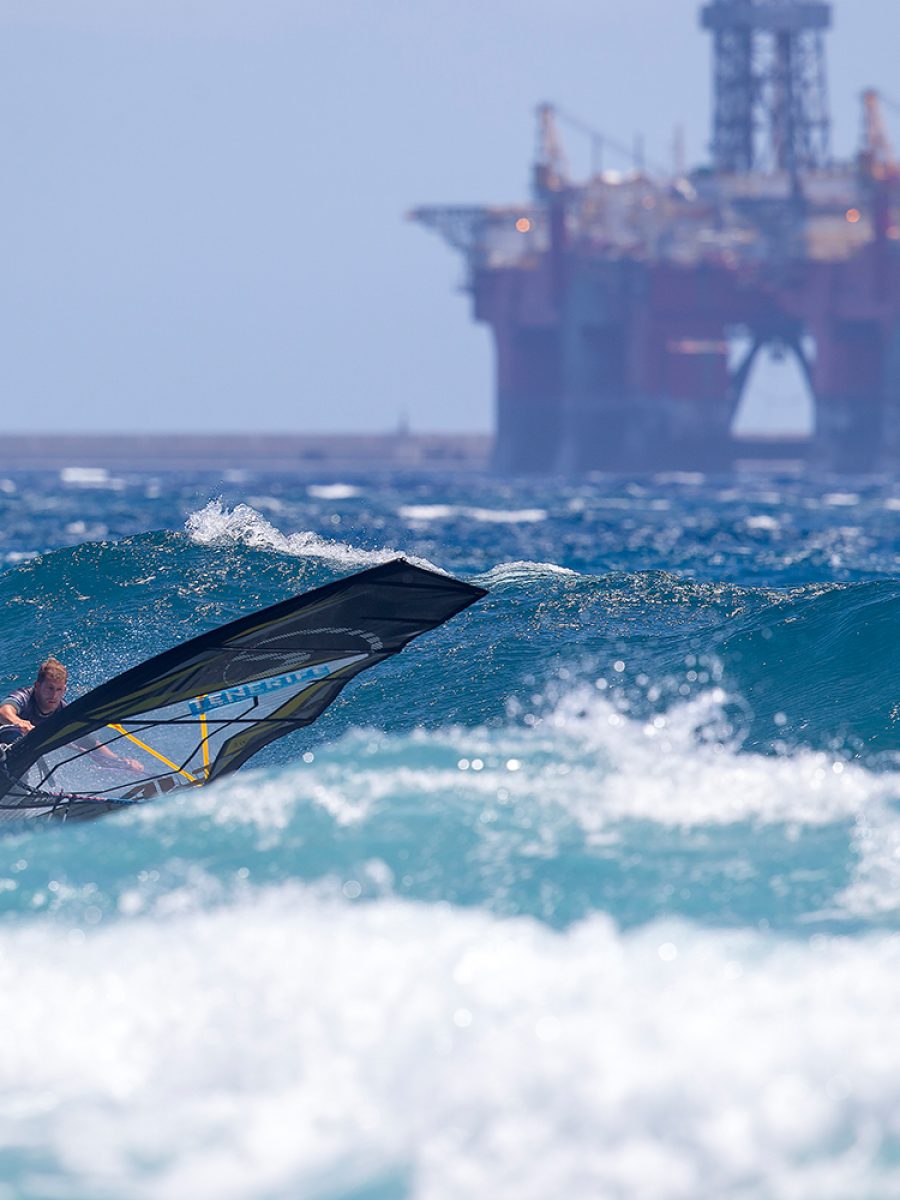
RICARDO CAMPELLO
In Tenerife I had a problem getting speed, my new boards were not really made for these sort of waves. Luckily I brought my Maui board, I did not think it would work here but it actually does. It has a lot of curve. It is tough to create speed here because the wind is kind of onshore and there is no power in the wave. It is tough. You also need a bigger sail. I always take a size bigger sail than normal here. You really need that power in the sail. I try to stay high on the wave, if you know a good gust is coming you can go lower and have more drive but it is tricky. I use quads, all my boards are quads, I am not into thrusters. My Ho’okipa board is a bit small at 82 litres but it works fine when the wind is there. At this competition some of the heats were sailed in very marginal conditions. Brawzinho and Philip were on 5.5m and 5.7m and neither of them could plane. Philip nailed a double on the first ramp but after that the wind died. It is what it is!
“ I always take a size bigger sail than normal.”
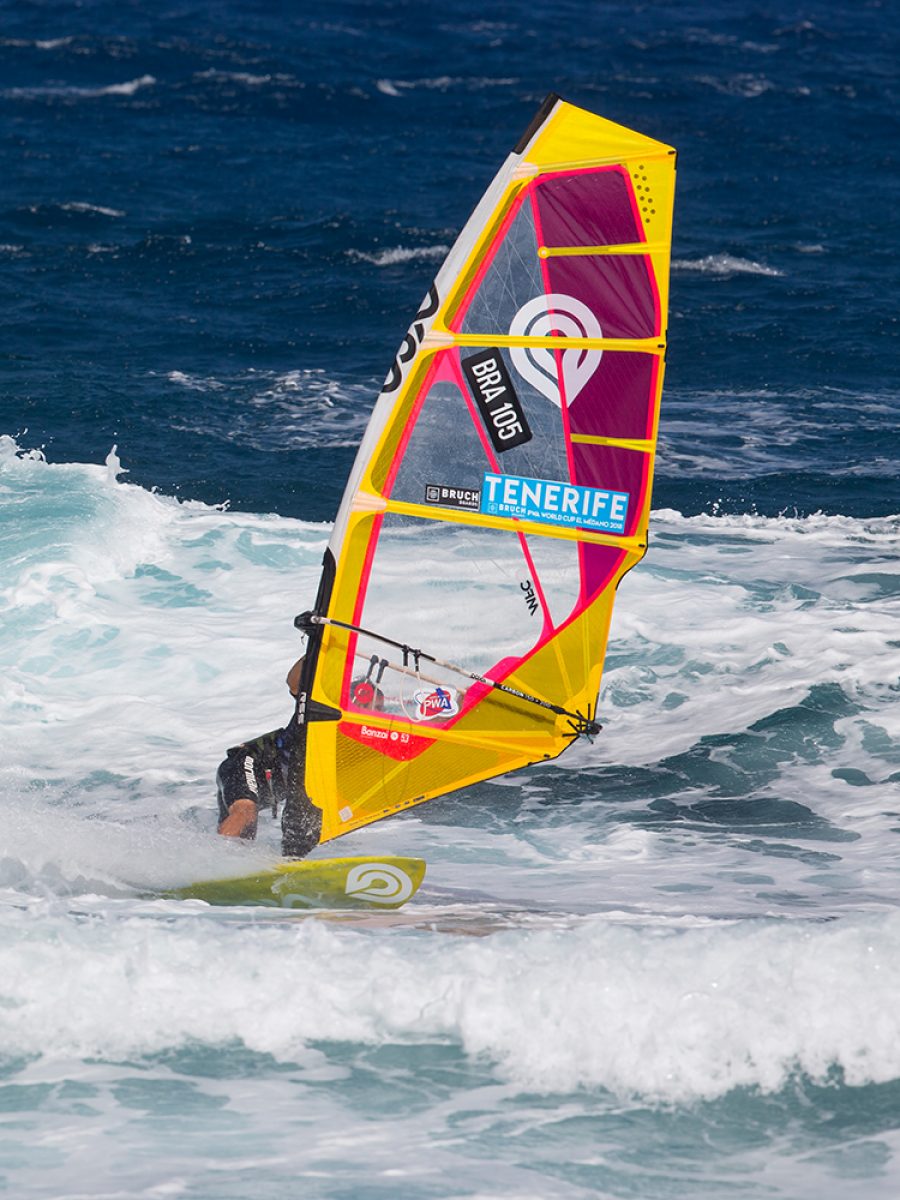
MARCILIO BROWNE
The first thing I would say is that no one should be scared of riding big stuff when they are sailing onshore places. It is very different from Ho’okipa or Cape Verde, where you almost want to be underpowered on the sail. For Tenerife I always like to sail with big enough gear that I am pretty much a bit overpowered on the outside and so like that I would feel comfortable wave riding on the inside. Also, I tend to scale up my board sizes. I would ride an 84 litre from 4.0m to 4.7m and 94 with 5.0m and 5.3m. Usually at Ho’okipa I can ride 84 with 5.0m no problem. In those conditions I also try to use faster/straighter fins that get planing earlier and also pivot a bit more. As for Ho’okipa, I ride fins with more rake and a longer/narrower setup that helps to draw out bigger turns.
Off the water training I just try to keep my joints strong to avoid injuries by doing yoga, cycling, surfing and gym. I also try to stay as light as I can, especially if I’m going to a light wind spot. I feel like for wave sailing, in general it helps to be lighter instead of heavier.
On the wave my tips would be to really pick the good part of the wave, and stay high and close to the wave, to use the power from it to generate speed. Making sure to really open the clew on the bottom turn is also very helpful, as it allows a bigger range and helps being able to get more vertical. The bottom turn is also a bit different, almost a two motion thing. I first try to set the front rail of the board, and than open the clew to see where I am going and to avoid getting back-winded.
“ I tend to scale up my board sizes.”
JASON DIFFIN – GOYA SAIL DESIGNER
On the sails, the key point to generating speed is to have plenty of draft shape, or profile in the sail. This shape will help generate more lift and speed to help drive you and the board through the water. In onshore or light conditions you really need to have that power to keep you moving. On all my Goya wave designs, the outhaul is where you control the power. If the wind is light, or the conditions are onshore or a bit gutless, then make sure to use a lighter outhaul tension so the sail can generate the most lift from the wind available.
Even with lighter outhaul tensions, the progressive twist (loose leech) cut in the sails will help maintain control by keeping the power locked low and forward in the sail. This allows you to run fuller profiles while still having great control, easy handling and a sail that pulls well, but doesn’t want to pitch you. Outhaul tension regulates power, downhaul gives control. Also key to light wind performance is using light rig components – mast and boom particularly. Light weight and good stiffness really translate to more power and glide and better control overall as well.
Last point – and this is a big one for light wind – is batten tension. Making sure your battens are correctly tightened creates proper skin tension in the sail and allows the most direct transfer of wind energy into forward motion. Think of your sail like a drum – you want it to sing, not “thud” when the wind hits it. Loose battens soften the sail, flatten the sail (intended shape isn’t pushed in to sail body profile), and will have a less direct, mushy feeling. Lower battens require more tension as they are longer and support more shape. Battens should be tightened until all vertical wrinkles in the sail body around the batten pocket disappear, and the sail body is clean and smooth. Over tightened battens will start to S-bend, so tighten the battens until they are clean and smooth, but not so much that they S-bend or are hard to rotate. A sail that is otherwise perfectly rigged loses about 10% of performance if the battens are not tightened properly. That’s a lot! In conditions where you are trying to generate speed, all these details can add up to really big results on the water.
“ The key point to generating speed is to have plenty of draft shape, or profile in the sail.”
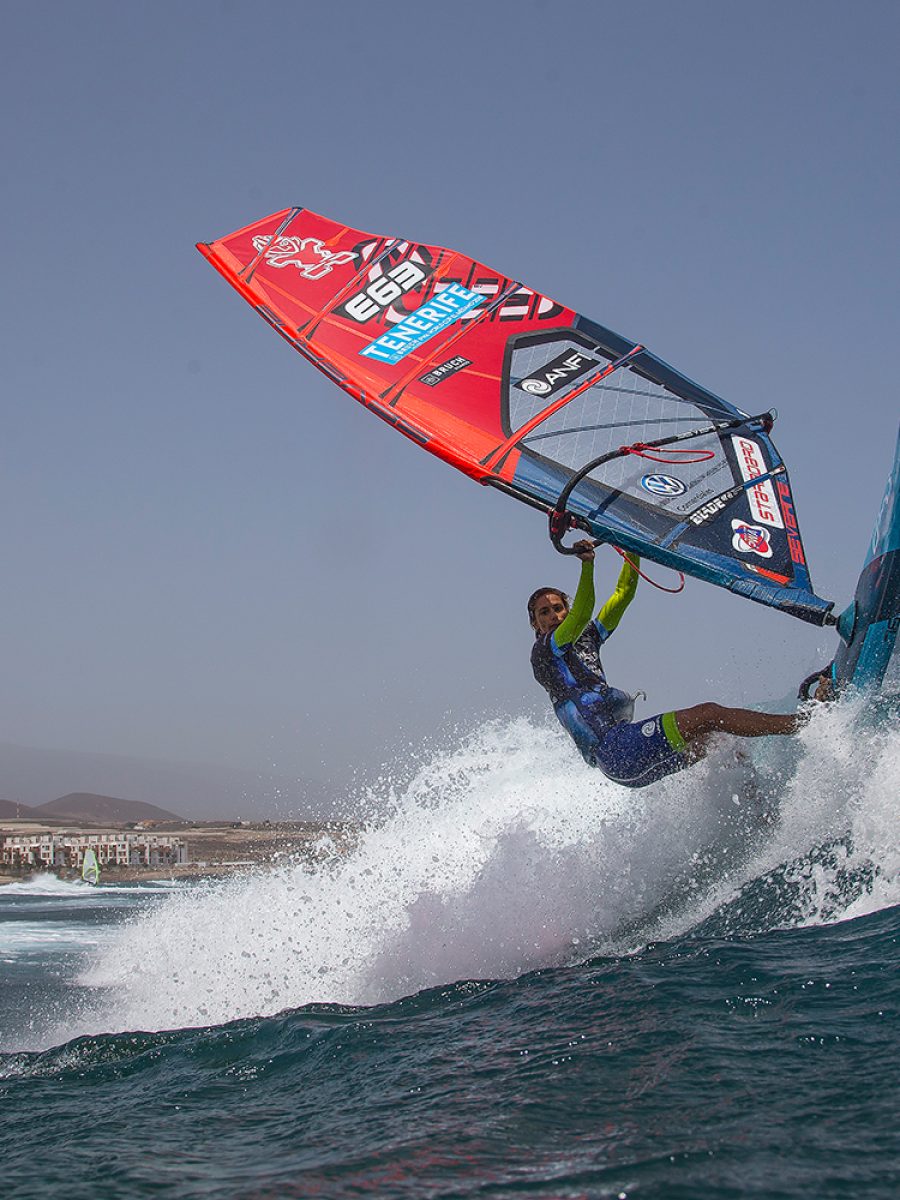
SARAH-QUITA OFFRINGA
The point is to stay on top of the wave as you have to make the speed from the wave. If you move away from the wave and you don’t have power in the sail then you lose the speed. So you just have to stay close to the wave. I have used a few different setups but in the lightest conditions I am on my 86 litre and 5.0m sail. You have to stay high on the wave, that is the key!
“ Stay high on the wave, that is the key!”
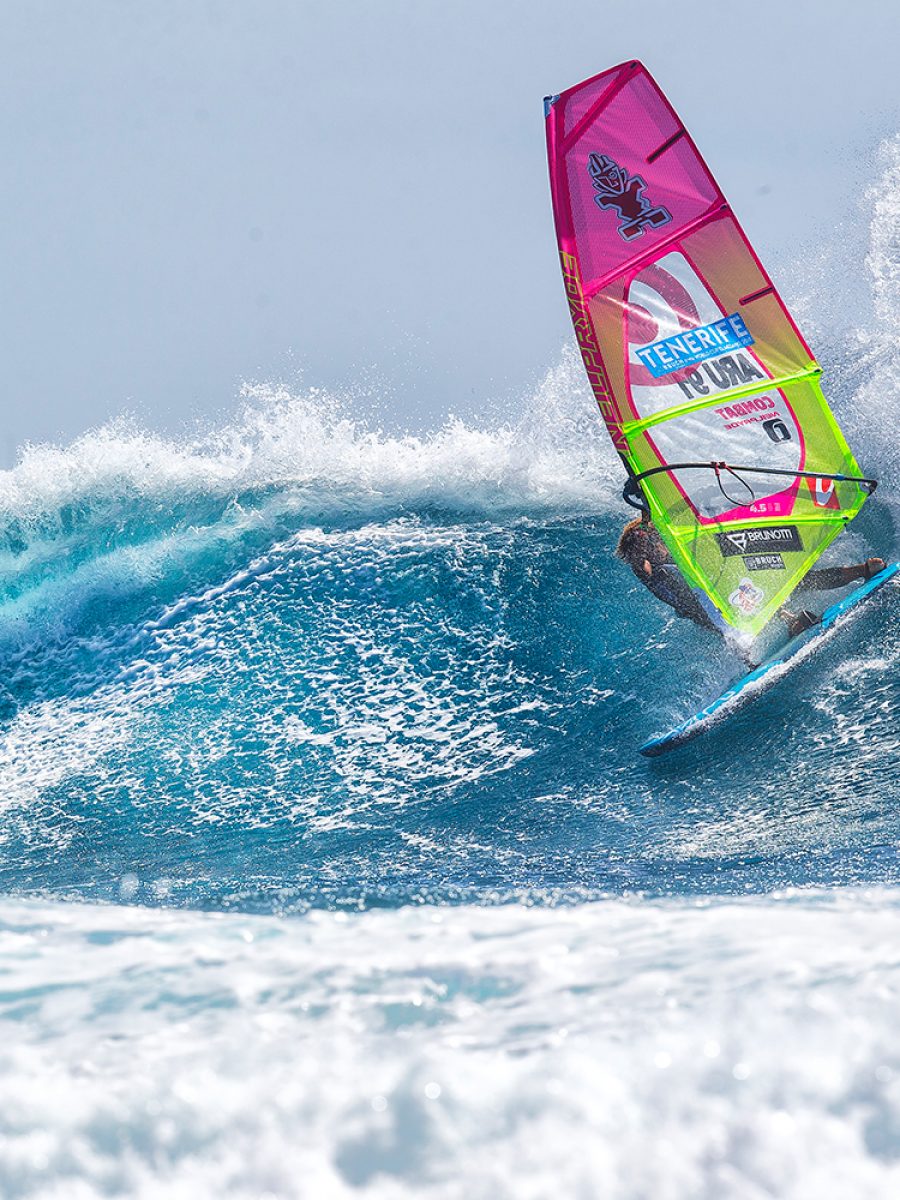
IBALLA MORENO
When it is onshore like in Tenerife you need to have a big enough board and sail. Instead of riding down the line you need to drop to the bottom of the wave and then go more vertical opening your sail on the bottom turn. I normally use a 4.7m and a 76 litre board, but I only weigh 60 kilos, so for the guys they are on 90 litre boards and 5.3m sails when it’s light here. I use a thruster, the new 76 litre UltraKode. That board is the one I ride the most overall in Tenerife and Fuerteventura. In Gran Canaria I use the 72 litre. You need to work on the sail a lot when you are riding, almost like pumping. Flexing your knees and going low on the bottom turn also. It is a bit like surfing in mushy waves. In surfing it is a bit different because you generate the speed pumping on the wall of the wave. For windsurfing you are using the sail, so you need to go down and then up vertically, opening the clew a lot. I watch a lot of videos to help visualization, so I understand where the wind is coming from. I like to watch Jaeger, his style is one of the best ones for sure, you learn a lot from watching him.
“ You need to have a big enough board and sail”
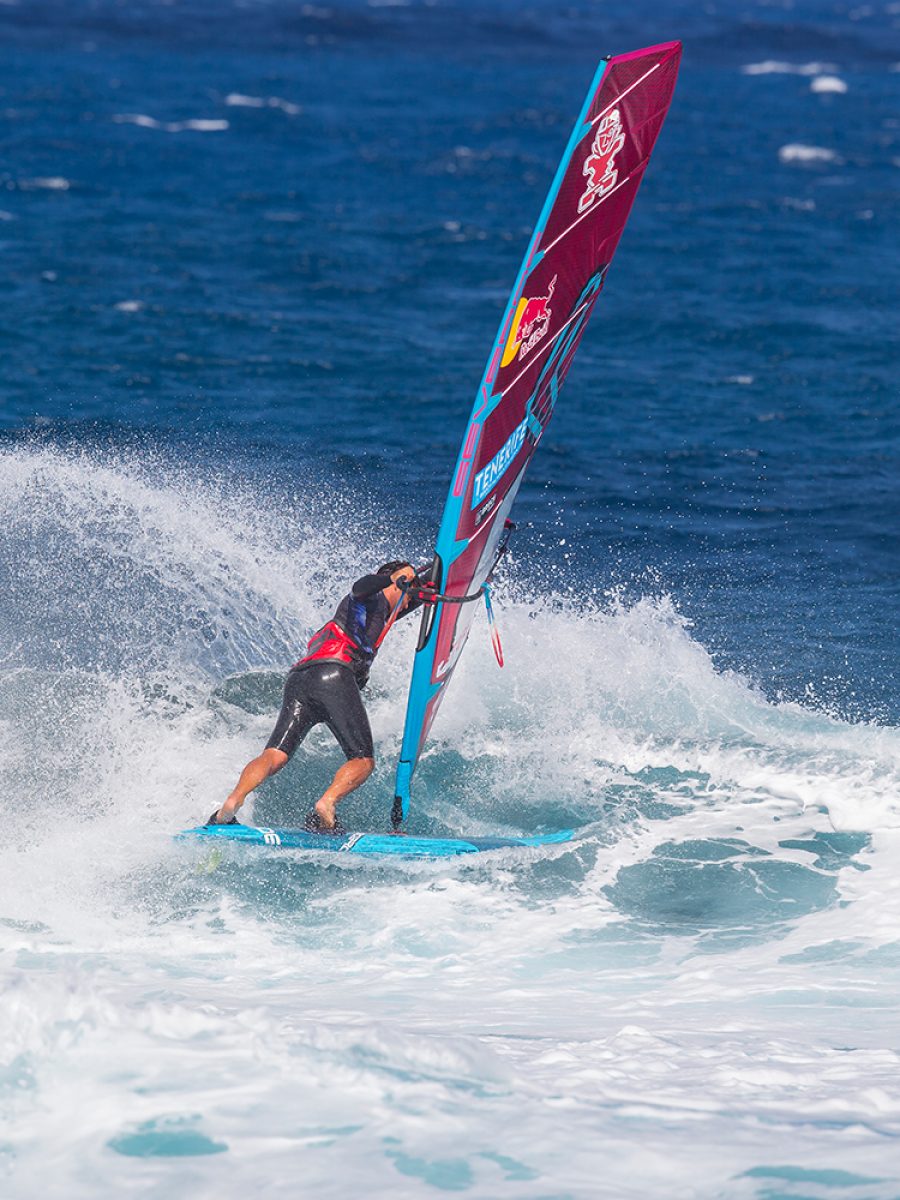
PHILIP KOESTER
I try and fill the sail up with a lot of wind and pump as much as possible in the bottom turn so I can get speed and reach the top of the wave again. I have been training a lot at home in light winds. I have a 105 litre board so that helped in Tenerife. The biggest sail I used was a 5.7m but most of the time I was on a 5.3m. Nothing really felt like it worked for me when it was very light. When the conditions were much better it was no problem, but we had a few heats in very marginal conditions. In the heat against Brawzinho the wind just stopped. I tried to stay high on the wave but actually you had to drop low to get the right speed to make it up again. It was very tricky sailing. You are actually surfing the wave more than windsurfing. Then I bring in new tricks like the reverse rather than wave riding.
I was on a production twin fin. I just took bigger fins, 17.5 cm, normally I use 16 cm. That seemed to work ok. If they keep on running in very marginal conditions though I will have to find a bigger board that planes really fast. My boards still work, but I do not know where the competition wind limit is anymore!
“ Pump as much as possible in the bottom turn.”
The post ONSHORE SPEED appeared first on Windsurf Magazine.